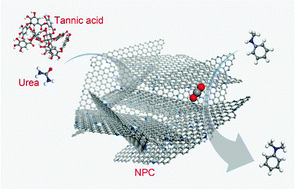Biomass-derived N-doped porous carbon: an efficient metal-free catalyst for methylation of amines with CO2†
Abstract
Developing green, efficient, and low-cost catalysts for methylation of N–H by using CO2 as the C1 resource is highly desired yet remains a significant challenge. Herein, N-doped porous carbons (NPCs) were designed, synthesized, and proved to be an excellent metal-free catalyst for CO2-participated methylation conversion. NPCs were prepared via the pyrolysis of a mixture of tannic acid and urea. Both theoretical calculation and experiment demonstrate that the N species especially pyridinic N and pyrrolic N within NPCs can work as Lewis basic sites for attacking CO2 to weaken the C![[double bond, length as m-dash]](https://www.rsc.org/images/entities/char_e001.gif) O bonds and lower the molecule conversion barrier, facilitating the subsequent methylation of N–H to produce, for example, N,N-dimethylaniline. Besides, the unique porous structure can enrich CO2 and accelerate mass transfer, synergistically promoting the conversion of CO2. The optimized NPC(1/5) catalyst, integrating the porous structure and strong Lewis basicity, exhibits excellent catalytic activity for CO2-based methylation reaction under mild conditions (1 bar CO2, 75 °C). Our work, for the first time, demonstrates the feasibility of using NPCs to catalyze the methylation of amino compounds to produce N,N-dimethylamine by exploiting CO2 as the C1 resource.
O bonds and lower the molecule conversion barrier, facilitating the subsequent methylation of N–H to produce, for example, N,N-dimethylaniline. Besides, the unique porous structure can enrich CO2 and accelerate mass transfer, synergistically promoting the conversion of CO2. The optimized NPC(1/5) catalyst, integrating the porous structure and strong Lewis basicity, exhibits excellent catalytic activity for CO2-based methylation reaction under mild conditions (1 bar CO2, 75 °C). Our work, for the first time, demonstrates the feasibility of using NPCs to catalyze the methylation of amino compounds to produce N,N-dimethylamine by exploiting CO2 as the C1 resource.



 Please wait while we load your content...
Please wait while we load your content...